Surface Mesonet and Upper Air Analysis of the 21 August 2017 Total Solar Eclipse
Abstract
:1. Introduction
2. Data and Methods
2.1. Surface Mesonet
2.2. Quantum Weather® Quality Control/Assurance
- Assess the quality and correct for any known biases in a real-time basis so the mesonet data can be used to produce on-demand forecasts;
- Augment data archives with a trustworthy assessment of the confidence in each datum, create biases corrections as necessary; and
- Assess the ongoing performance of the network to keep current and future data quality at the highest level that is operationally possible.
2.3. Methdology
2.4. Radiosonde Observations
2.5. Assessing Contamination of Mesonet Data by Nearby Convective Complexes
3. Results
3.1. Domain Surface Temperature Response
3.2. Time Series Response—Surface Temperature Sensors
3.3. Time Series Response—Surface Pressure Sensors
3.4. Sounding Data
4. Summary
5. Conclusions
Author Contributions
Funding
Institutional Review Board Statement
Informed Consent Statement
Data Availability Statement
Acknowledgments
Conflicts of Interest
References
- Clayton, H.H.; Rotch, A.L.; Pickering, E.C. The eclipse cyclone and the diurnal cyclones. In Annals of the Astronomical Observatory of Harvard College; The Observatory: Cambridge, UK, 1901. [Google Scholar]
- Aplin, K.L.; Scott, C.J.; Gray, S.L. Atmospheric changes from solar eclipses. Philos. Trans. R. Soc. Math. Phys. Eng. Sci. 2016, 374, 20150217. [Google Scholar] [CrossRef] [PubMed]
- Ahrens, D.; Iziomon, M.G.; Jaeger, L.; Matzarakis, A.; Mayer, H. Impacts of the solar eclipse of 11 August 1999 on routinely recorded meteorological and air quality data in south-west Germany. Meteorol. Z. 2001, 10, 215. [Google Scholar] [CrossRef]
- Hanna, E. Meteorological effects of the solar eclipse of 11 August 1999. Weather 2000, 55, 430–446. [Google Scholar] [CrossRef]
- Founda, D.; Melas, D.; Lykoudis, S.; Lisaridis, I.; Gerasopoulos, E.; Kouvarakis, G.; Petrakis, M.; Zerefos, C. The effect of the total solar eclipse of 29 March 2006 on meteorological variables in Greece. Atmos. Chem. Phys. 2007, 7, 5543–5553. [Google Scholar] [CrossRef]
- Mahmood, R.; Schargorodski, M.; Rappin, E.; Griffin, M.; Collins, P.; Knupp, K.; Quilligan, A.; Wade, R.; Cary, K. The total solar eclipse of 2017: Meteorological observations from a statewide mesonet and atmospheric profiling systems. Bull. Am. Meteorol. Soc. 2020, 101, E720–E737. [Google Scholar] [CrossRef]
- Turner, D.D.; Wulfmeyer, V.; Behrendt, A.; Bonin, T.A.; Choukulkar, A.; Newsom, R.K.; Brewer, W.A.; Cook, D.R. Response of the land-atmosphere system over north-central Oklahoma during the 2017 eclipse. Geophys. Res. Lett. 2018, 45, 1668–1675. [Google Scholar] [CrossRef]
- Gray, S.L.; Harrison, R.G. Eclipse induced wind changes over the British Isles on the 20 March 2015. Philos. Trans. R. Soc. A Math. Phys. Eng. Sci. 2016, 374, 20150224. [Google Scholar] [CrossRef]
- Burt, S. Meteorological responses in the atmospheric boundary layer over southern England to the deep partial eclipse of 20 March 2015. Philos. Trans. R. Soc. A Math. Phys. Eng. Sci. 2016, 374, 20150214. [Google Scholar] [CrossRef]
- Fowler, J.; Wang, J.; Ross, D.; Colligan, T.; Godfrey, J. Measuring ARTSE2017: Results from Wyoming and New York. Bull. Am. Meteorol. Soc. 2019, 100, 1049–1060. [Google Scholar] [CrossRef]
- Colligan, T.; Fowler, J.; Godfrey, J.; Spangrude, C. Detection of stratospheric gravity waves induced by the total solar eclipse of July 2, 2019. Sci. Rep. 2020, 10, 19428. [Google Scholar] [CrossRef]
- Palomaki, R.T.; Babić, N.; Duine, G.J.; van den Bossche, M.; De Wekker, S.F. Observations of Thermally-Driven Winds in a Small Valley during the 21 August 2017 Solar Eclipse. Atmosphere 2019, 10, 389. [Google Scholar] [CrossRef]
- Harrison, R.G.; Marlton, G.J.; Williams, P.D.; Nicoll, K.A. Coordinated weather balloon solar radiation measurements during a solar eclipse. Philos. Trans. R. Soc. A Math. Phys. Eng. Sci. 2016, 374, 20150221. [Google Scholar] [CrossRef] [PubMed]
- Mazzarella, A.; Scafetta, N. Estimating Naples’ urban heat island effects using the March 20, 2015 partial solar eclipse. Cse-City Saf. Energy 2017, 63–69. [Google Scholar] [CrossRef]
- Vukovich, F.M.; King, W.J. A theoretical study of the St. Louis heat island: Comparisons between observed data and simulation results on the urban heat island circulation. J. Appl. Meteorol. 1980, 19, 761–770. [Google Scholar] [CrossRef]
- Fishman, J.; Belina, K.M.; Encarnación, C.H. The St. Louis ozone gardens: Visualizing the impact of a changing atmosphere. Bull. Am. Meteorol. Soc. 2014, 95, 1171–1176. [Google Scholar] [CrossRef]
- Mainhart, M.; Pasken, R.; Chiao, S.; Roark, M. Surface mesovortices in relation to the urban heat island effect over the Saint Louis metropolitan area. Urban Clim. 2020, 31, 100580. [Google Scholar] [CrossRef]
- Goodwin, G.L.; Hobson, G.J. Atmospheric gravity waves generated during a solar eclipse. Nature 1978, 275, 109–111. [Google Scholar] [CrossRef]
- Buban, M.S.; Lee, T.R.; Dumas, E.J.; Baker, C.B.; Heuer, M. Observations and Numerical Simulation of the Effects of the 21 August 2017 North American Total Solar Eclipse on Surface Conditions and Atmospheric Boundary-Layer Evolution. Bound.-Layer Meteorol. 2019, 171, 257–270. [Google Scholar] [CrossRef]
- Shafer, M.A.; Fiebrich, C.A.; Arndt, D.S.; Fredrickson, S.E.; Hughes, T.W. Quality assurance procedures in the Oklahoma Mesonetwork. J. Atmos. Ocean. Technol. 2000, 17, 474–494. [Google Scholar] [CrossRef]
- Barnes, S.L. Applications of the Barnes objective analysis scheme. Part I: Effects of undersampling, wave position, and station randomness. J. Atmos. Ocean. Technol. 1994, 11, 1433–1448. [Google Scholar] [CrossRef]
- Barnes, S.L. Applications of the Barnes objective analysis scheme. Part II: Improving derivative estimates. J. Atmos. Ocean. Technol. 1995, 11, 1449–1458. [Google Scholar] [CrossRef]
- Barnes, S.L. Applications of the Barnes objective analysis scheme. Applications of the Barnes Objective Analysis Scheme. Part III: Tuning for Minimum Error. J. Atmos. Ocean. Technol. 1995, 11, 1449–1479. [Google Scholar] [CrossRef]
- Martin, C.; Suhr, I. NCAR/EOL Atmospheric Sounding Processing ENvironment (ASPEN) Software. Version 3.4.5. 2021. Available online: https://www.eol.ucar.edu/content/aspen (accessed on 1 June 2022).
- Beer, T. Supersonic Generation of Atmospheric Waves. Nature 1973, 242, 34. [Google Scholar] [CrossRef]
- Nayak, C.; Yiğit, E. GPS-TEC observation of gravity waves generated in the ionosphere during 21 August 2017 total solar eclipse. J. Geophys. Res. Space Phys. 2018, 123, 725–738. [Google Scholar] [CrossRef]
- Amiridis, V.; Melas, D.; Balis, D.S.; Papayannis, A.; Founda, D.; Katragkou, E.; Giannakaki, E.; Mamouri, R.E.; Gerasopoulos, E.; Zerefos, C. Aerosol Lidar observations and model calculations of the Planetary Boundary Layer evolution over Greece, during the March 2006 Total Solar Eclipse. Atmos. Chem. Phys. 2007, 7, 6181–6189. [Google Scholar] [CrossRef]
- Seidel, D.J.; Zhang, Y.; Beljaars, A.; Golaz, J.; Jacobson, A.R.; Medeiros, B. Climatology of the planetary boundary layer over the continental United States and Europe. J. Geophys. Res. Atmos. 2012, 117, D17106. [Google Scholar] [CrossRef]
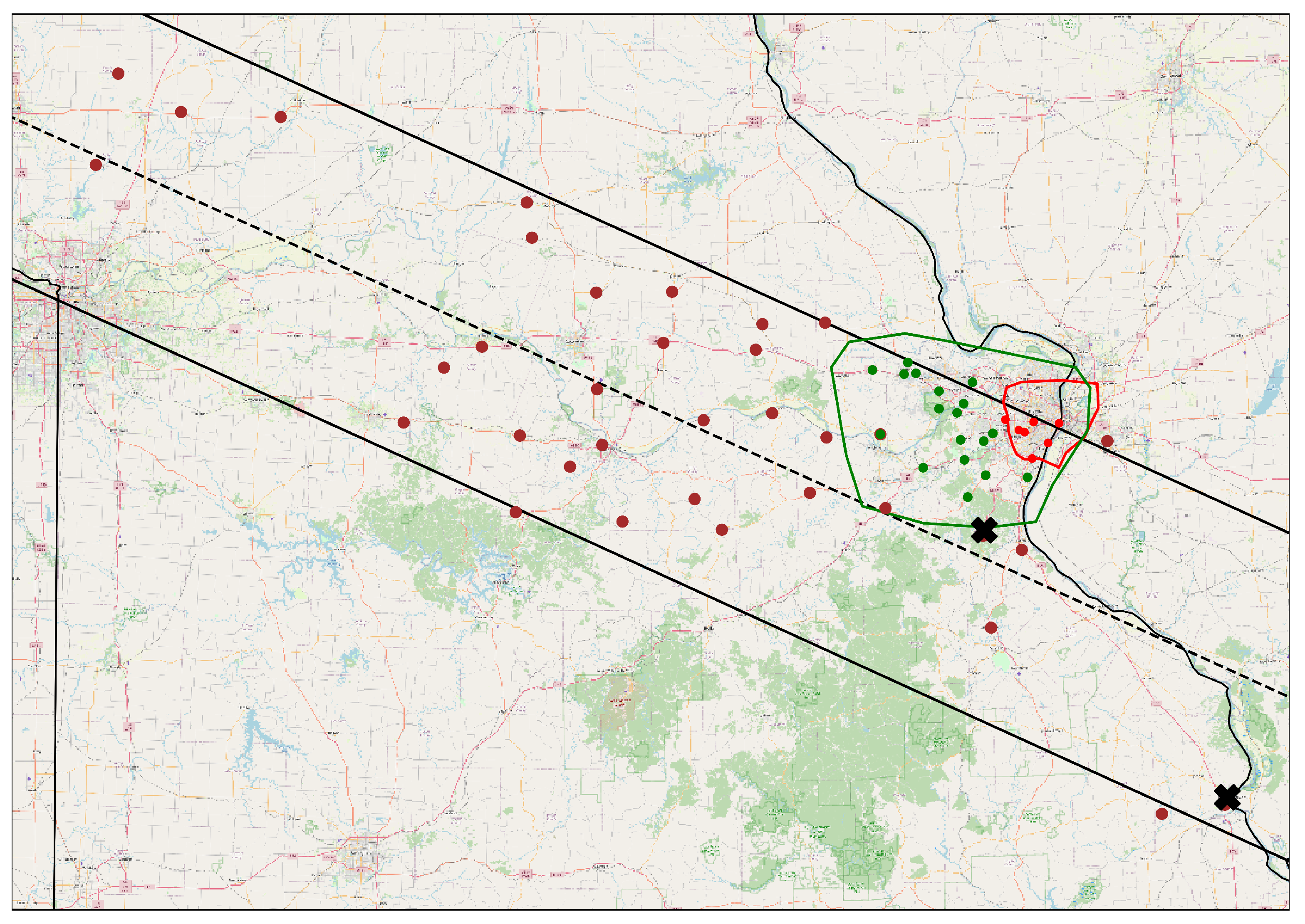

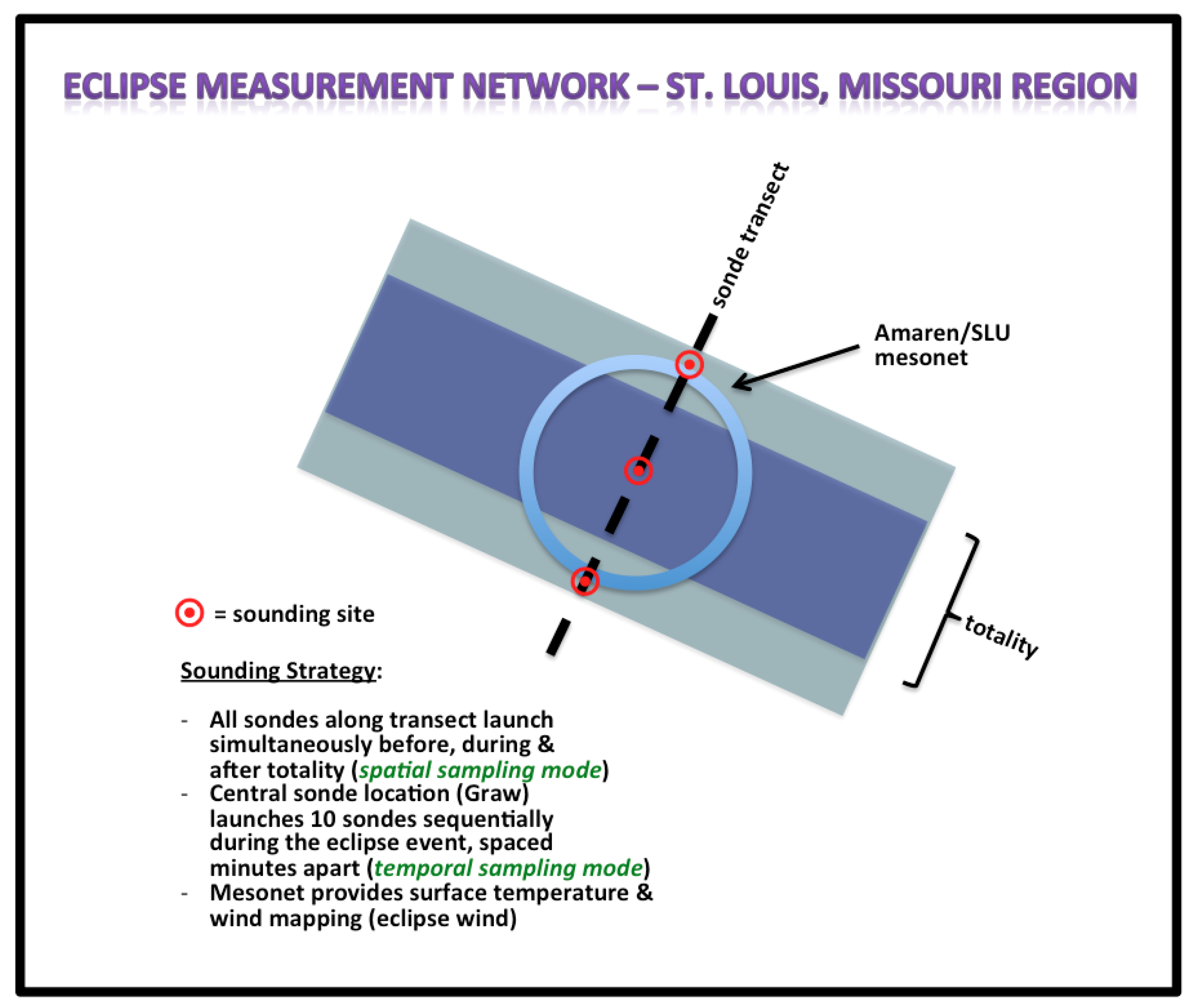





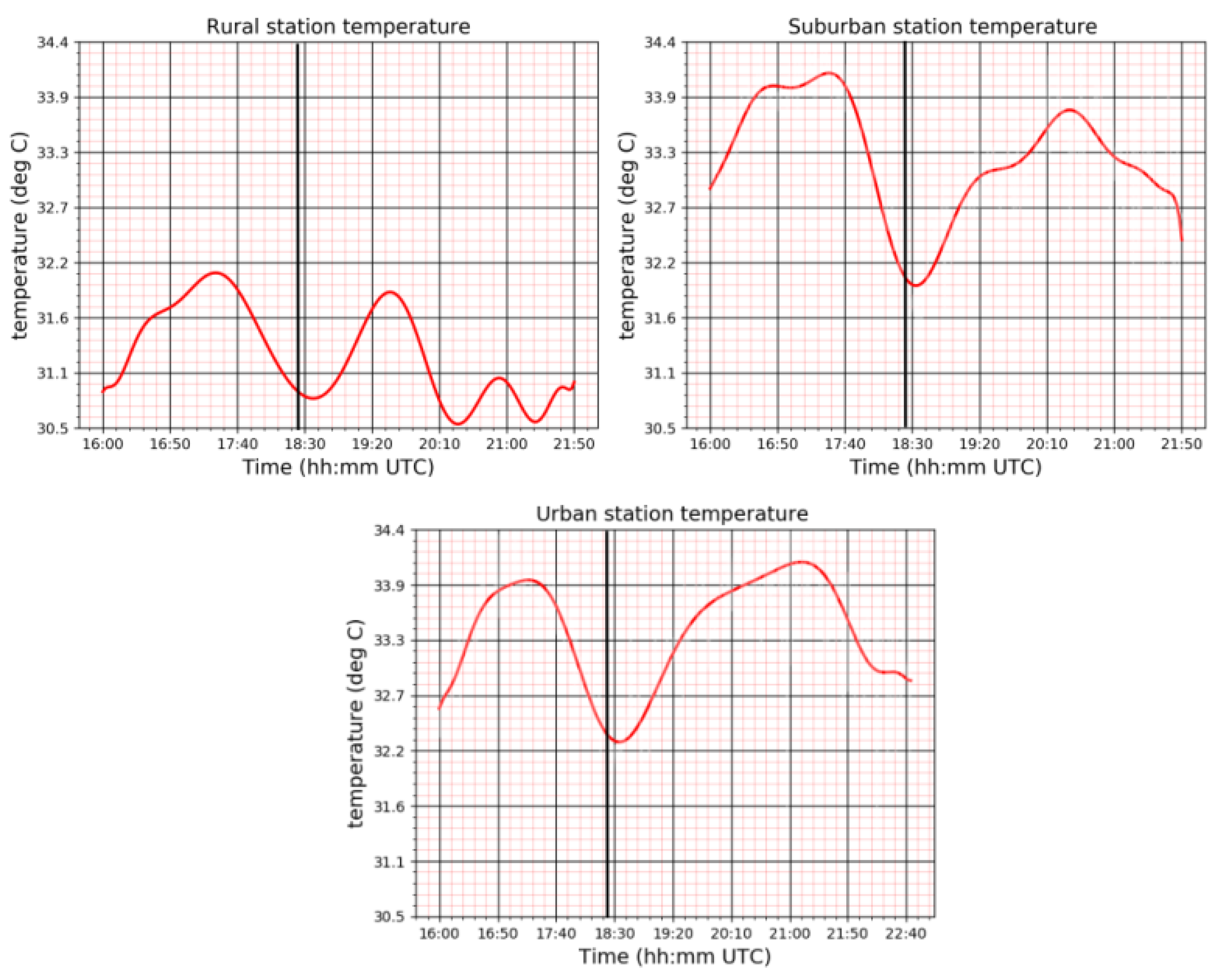
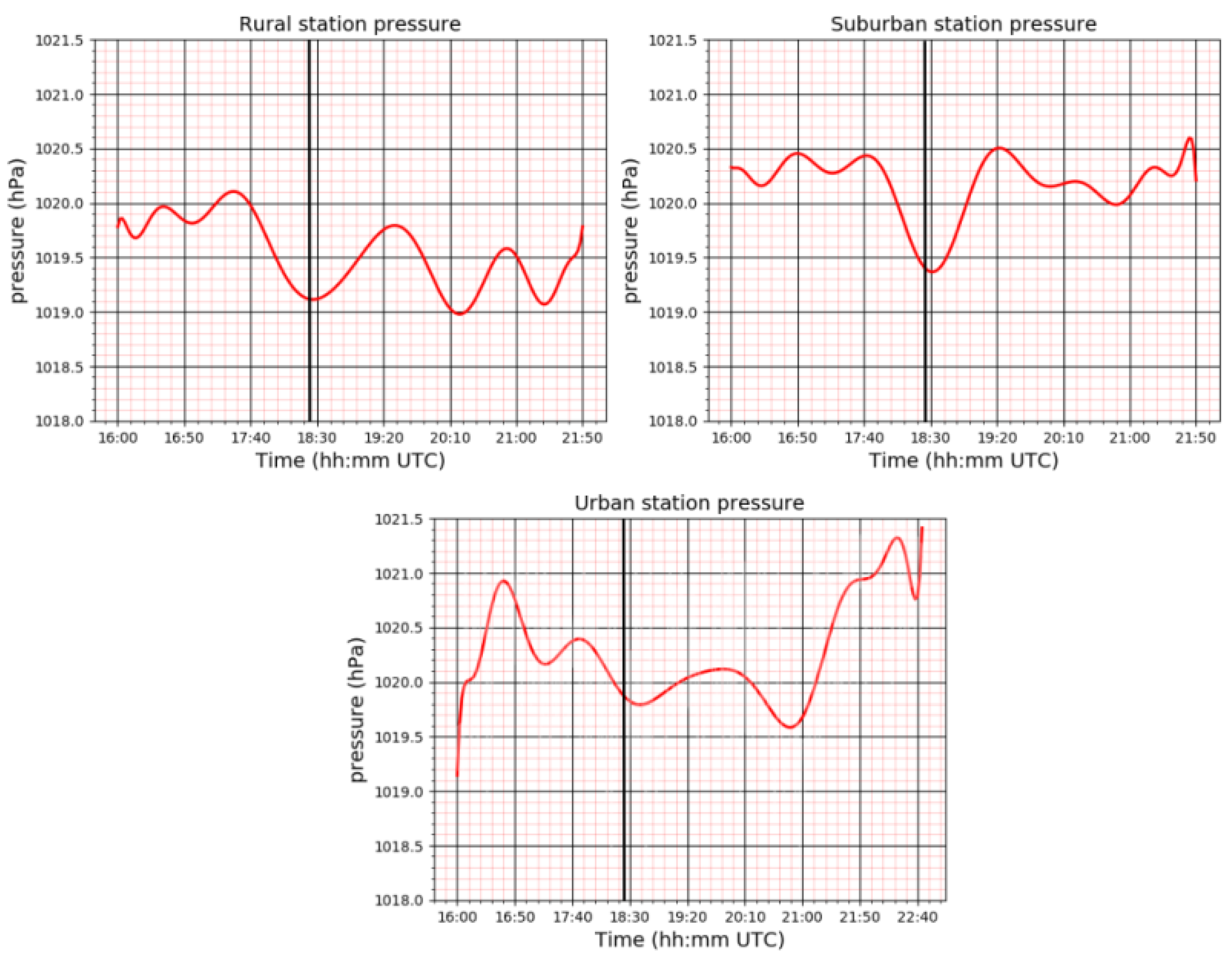
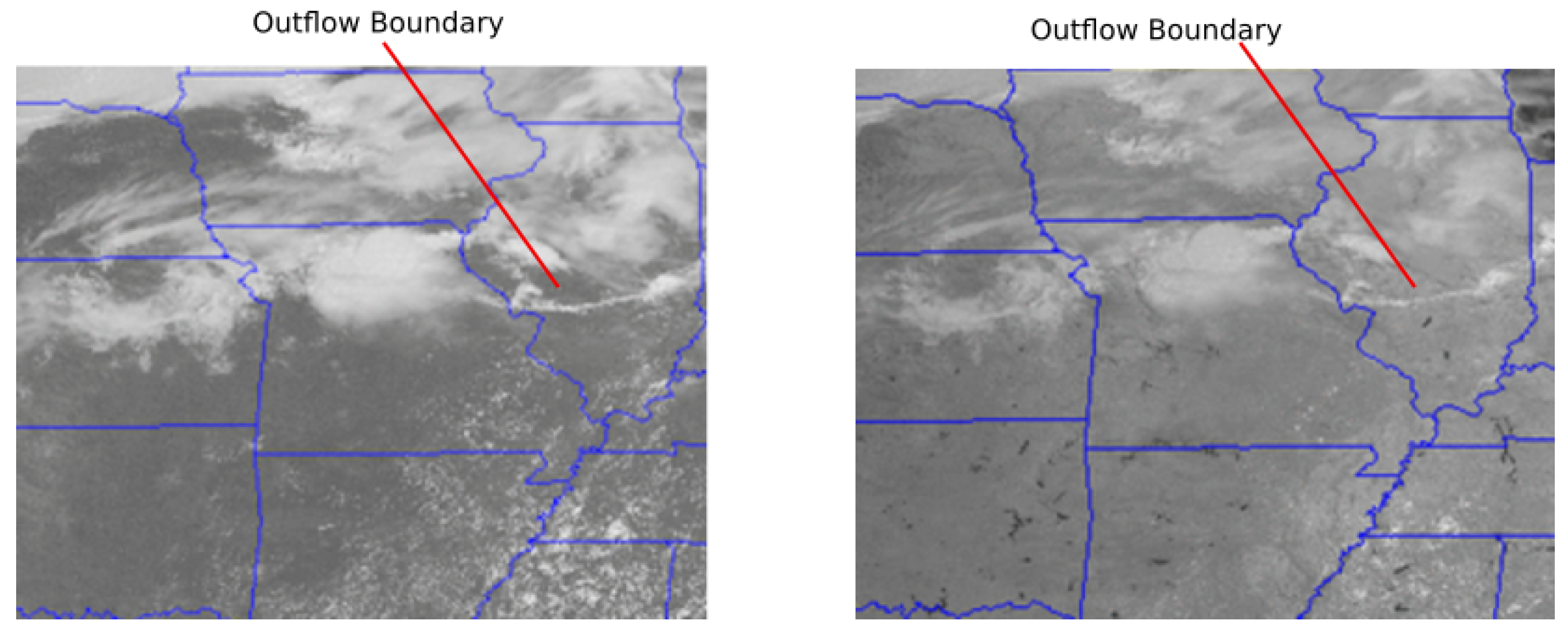
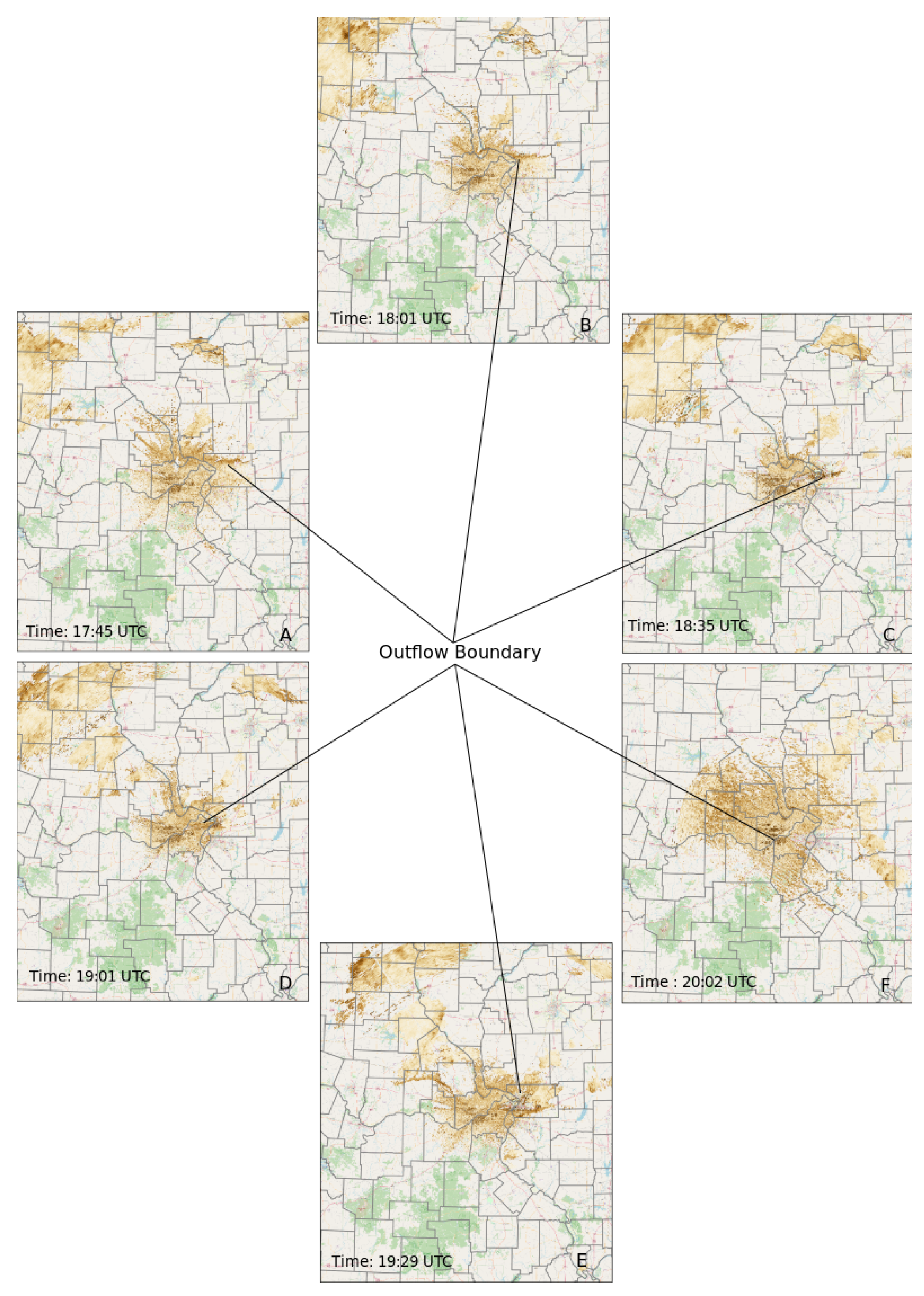

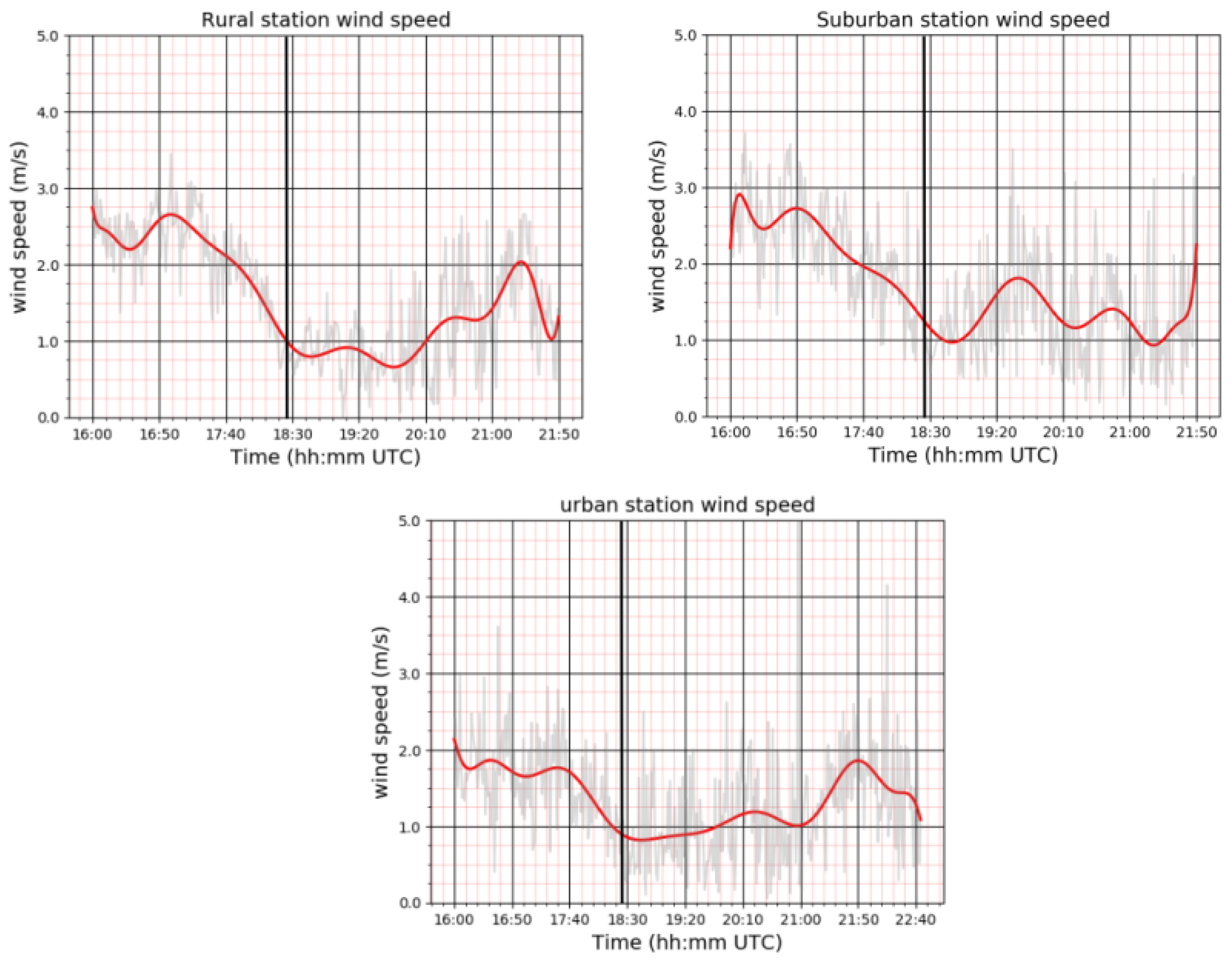

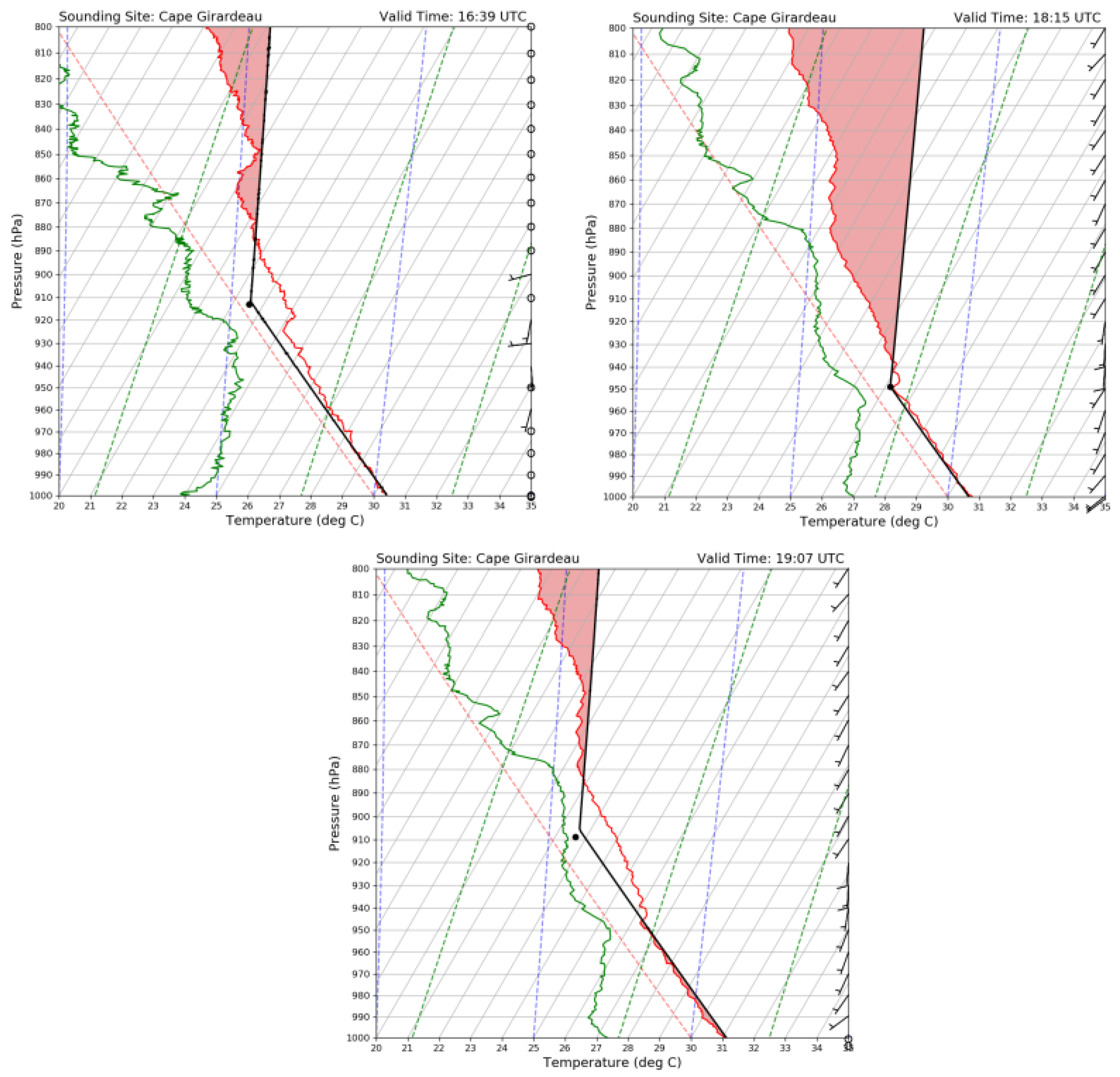
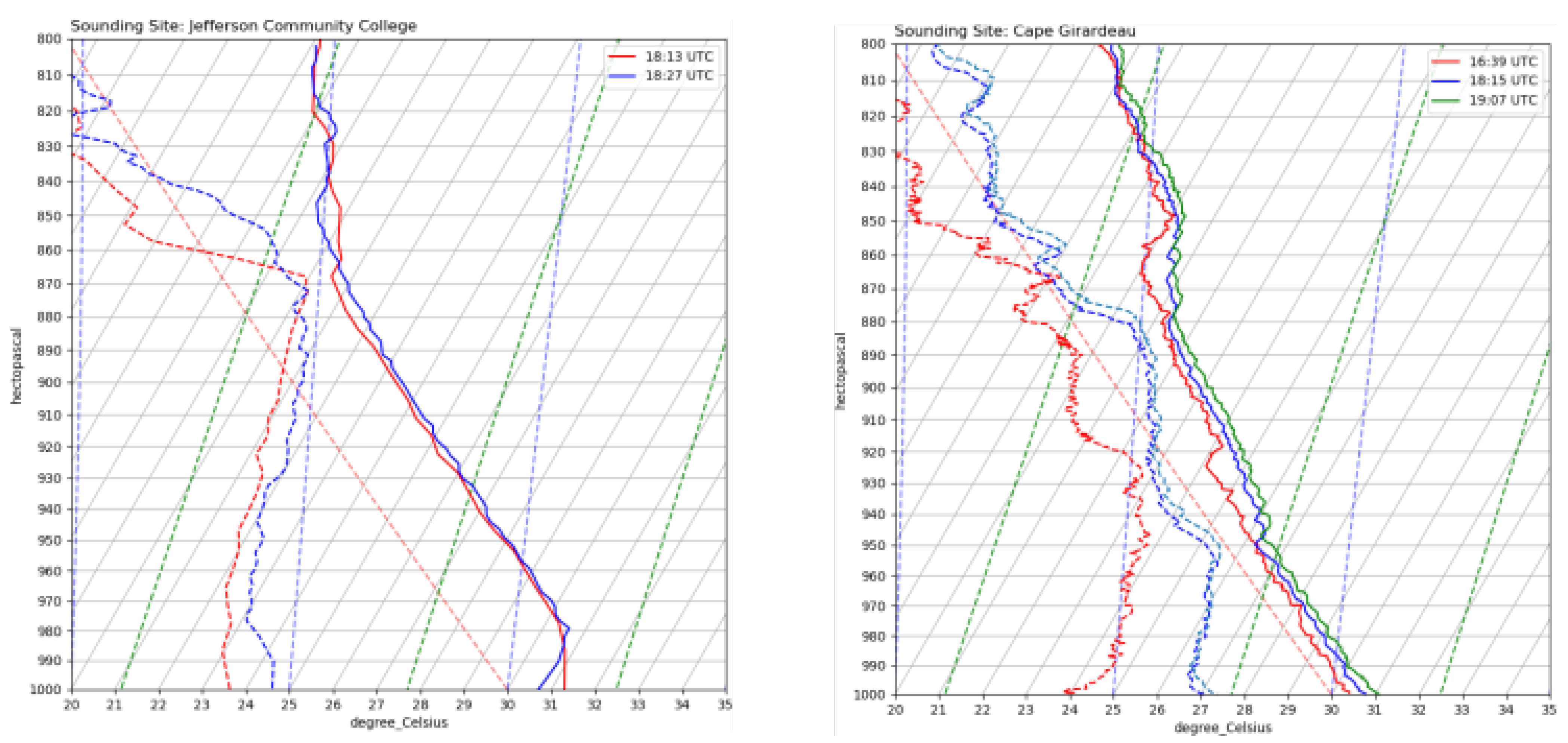
| First Contact | Totality Start | Totality End | Last Contact | |
|---|---|---|---|---|
| Western Missouri (Saint Joseph) | 16:40:34 | 18:06:19 | 18:08:57 | 19:34:27 |
| Central Missouri (Jefferson City) | 16:46:05 | 18:13:08 | 18:15:35 | 19:41:04 |
| Eastern Missouri (Cape Girardeau) | 16:51:55 | 18:20:20 | 18:22:02 | 19:47:34 |
| Jefferson Community College | ||
|---|---|---|
| Time | Richardson | Capping |
| 18:13 UTC | 861 hPa | 858 hPa |
| 18:27 UTC | 834 hPa | 848 hPa |
| Cape Girardeau | ||
| Time | Richardson | Capping |
| 16:39 UTC | 861 mb | 858 mb |
| 18:13 UTC | 878 mb | 880 mb |
| 19:07 UTC | 873 mb | 878 mb |
| Jefferson Community College | |||
|---|---|---|---|
| Time | LCL | CAPE | CIN |
| 18:13 UTC | 894 hPa | 13.8 J/Kg | −32.9 J/Kg |
| 18:27 UTC | 920 hPa | 43.2 J/Kg | −23.7 J/Kg |
| Cape Girardeau | |||
| Time | LCL | CAPE | CIN |
| 16:09 UTC | 912 hPa | 811.6 J Kg | −12.3 J Kg |
| 18:15 UTC | 947 hPa | 1661.3 J kG | −0.03J Kg |
| 19:07 UTC | 949 hPa | 1834.5 J Kg | 0.0 J Kg |
Disclaimer/Publisher’s Note: The statements, opinions and data contained in all publications are solely those of the individual author(s) and contributor(s) and not of MDPI and/or the editor(s). MDPI and/or the editor(s) disclaim responsibility for any injury to people or property resulting from any ideas, methods, instructions or products referred to in the content. |
© 2023 by the authors. Licensee MDPI, Basel, Switzerland. This article is an open access article distributed under the terms and conditions of the Creative Commons Attribution (CC BY) license (https://creativecommons.org/licenses/by/4.0/).
Share and Cite
Pasken, R.; Halverson, J.; Braunschweig, P. Surface Mesonet and Upper Air Analysis of the 21 August 2017 Total Solar Eclipse. Atmosphere 2023, 14, 1412. https://doi.org/10.3390/atmos14091412
Pasken R, Halverson J, Braunschweig P. Surface Mesonet and Upper Air Analysis of the 21 August 2017 Total Solar Eclipse. Atmosphere. 2023; 14(9):1412. https://doi.org/10.3390/atmos14091412
Chicago/Turabian StylePasken, Robert, Jeffrey Halverson, and Peter Braunschweig. 2023. "Surface Mesonet and Upper Air Analysis of the 21 August 2017 Total Solar Eclipse" Atmosphere 14, no. 9: 1412. https://doi.org/10.3390/atmos14091412
APA StylePasken, R., Halverson, J., & Braunschweig, P. (2023). Surface Mesonet and Upper Air Analysis of the 21 August 2017 Total Solar Eclipse. Atmosphere, 14(9), 1412. https://doi.org/10.3390/atmos14091412






